Thursday, June 25, 2009
Third of Pelagic Sharks Threatened with Extinction
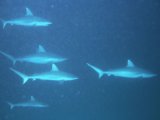 The first study to determine the global conservation status of 64 species of open ocean (pelagic) sharks and rays reveals that 32 percent are threatened with extinction, primarily due to overfishing, according to the IUCN Shark Specialist Group.
The first study to determine the global conservation status of 64 species of open ocean (pelagic) sharks and rays reveals that 32 percent are threatened with extinction, primarily due to overfishing, according to the IUCN Shark Specialist Group.“Despite mounting threats, sharks remain virtually unprotected on the high seas,” says Sonja Fordham, Deputy Chair of the IUCN Shark Specialist Group and Policy Director for the Shark Alliance. “The vulnerability and lengthy migrations of most open ocean sharks mean they need coordinated, international conservation plans. Our report documents serious overfishing of these species, in national and international waters, and demonstrates a clear need for immediate action on a global scale.”The report comes days before Spain hosts an international summit of fishery managers responsible for high seas tuna fisheries in which sharks are taken without limit. It also coincides with an international group of scientists meeting in Denmark to formulate management advice for Atlantic porbeagle sharks.
The study reports the Great Hammerhead (Sphyrna mokarran) and Scalloped Hammerhead (Sphyrna lewini) sharks, as well as Giant Devil Rays (Mobula mobular), as globally Endangered and facing a very high risk of extinction in the wild. Smooth Hammerheads (Sphyrna zygaena), Great White (Carcharodon carcharias), Basking (Cetorhinus maximus), Oceanic Whitetip (Carcharhinus longimanus), two species of Mako (Isurus spp.) and three species of Thresher (Alopias spp.) sharks are classed as globally Vulnerable to extinction ( facing a high risk of extinction in the wild).

Scalloped hammerhead (Sphyrna lewini)
(Image: Simon Rogerson)
Many open ocean sharks are taken mainly in high seas tuna and swordfish fisheries. Once considered only incidental “bycatch”, these species are increasingly targeted due to new markets for shark meat and high demand for their valuable fins, used in the Asian delicacy shark fin soup. To source this demand, the fins are often cut off sharks and the rest of the body is thrown back in the water, a process known as “finning”. Finning bans have been adopted for most international waters, but lenient enforcement standards hamper their effectiveness.
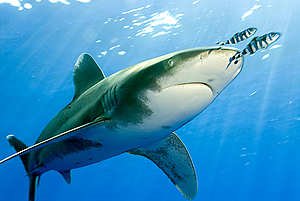
Oceanic Whitetip (Carcharhinus longimanus)
(Image: Simon Rogerson)
Sharks are particularly sensitive to overfishing due to their tendency to take many years to mature and have relatively few young. In most cases, pelagic shark catches are unregulated or unsustainable.
The IUCN Shark Specialist Group is calling on governments to set catch limits for sharks and rays based on scientific advice and the precautionary approach. It further urges governments to fully protect Critically Endangered and Endangered species of sharks and rays, ensure an end to shark finning and improve the monitoring of fisheries taking sharks and rays.

Silky (Carcharhinus falciformis)
(Image: Jeremy Stafford-Deitsch)
The IUCN uses a series of categories to classify species
| EXTINCT | The last individual has died |
| EXTINCT IN THE WILD | Only survives in captivity or cultivation |
| CRITICALLY ENDANGERED | Facing an extremely high risk of extinction in the wild |
| ENDANGERED | Facing a very high risk of extinction in the wild |
| VULNERABLE | Facing a high risk of extinction in the wild |
| NEAR THREATENED | Likely to qualify for, a threatened category in the near future |
| LEAST CONCERN | Does not qualify for any of the above |
is the world’s largest global environmental network. It is a
membership union with more than 1,000 government and
non-governmental member organisations and almost 11,000
volunteer scientists in more than 160 countries.
Further Reading:
The Conservation Status of Pelagic Sharks and Rays: Report of the IUCN Shark Specialist Group Pelagic Shark Red List Workshop
IUCN Red List Categories and Criteria booklet
Related Stories:
EU launches shark protection plan
Caribbean Big Fish Disappearing
Mediterranean Sharks Declining Fast
Mexico Passes Shark Finning Ban
Four Times more Sharks caught than Officially Reported
What do you think of this news item? Join a discussion.
Labels: fish, marine biology, research, SCUBA News, sealife, sharks
Monday, May 18, 2009
World's Largest Leatherback Turtle Population Found
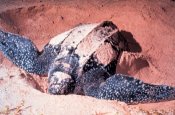 An international team of scientists has identified a nesting population of leatherback sea turtles in Gabon, West Africa as the world's largest.
An international team of scientists has identified a nesting population of leatherback sea turtles in Gabon, West Africa as the world's largest.The research, published in the May issue of Biological Conservation, involved country-wide land and aerial surveys that estimated a population of between 15,730 and 41,373 female turtles using the nesting beaches.
The study highlights the importance of conservation work to manage key sites and protected areas in Gabon.
Leatherbacks are of profound conservation concern around the world after populations in the Indo-Pacific crashed by more than 90 percent in the 1980s and 1990s. The International Union for Conservation of Nature (IUCN) lists leatherback turtles as critically endangered globally, but detailed population assessments in much of the Atlantic, especially Africa, are lacking.
During three nesting seasons between 2002 and 2007, the team’s members carried out the most comprehensive survey of marine turtles ever conducted in Gabon. This involved aerial surveys along Gabon’s 600 km (372 mile) coast, using video to capture footage for evaluation, and detailed ground-based monitoring. By covering the entire coastline, they were not only able to estimate the number of nests and nesting females, but also to identify the key sites for leatherback nesting, data which are crucial to developing conservation management plans for the species. Leatherbacks were first described nesting in Gabon in 1984.
The study also revealed that around 79 percent of the nesting occurs within National Parks and other protected areas. This gives added hope that Gabon can continue to be one of the world’s most important countries for these magnificent creatures.
Dr Angela Formia of the Wildlife Conservation Society, a co-author of the paper, said: “These findings show the critical importance of protected areas to maintain populations of sea turtles. Gabon should be commended for creating a network of National Parks in 2002 that have provided a sanctuary for this endangered species as well as other rare wildlife.”
The leatherback is the largest sea turtle, reaching up to nearly two metres (6.5 feet) in length and 540kg (1190 pounds) in weight. Unlike other sea turtles, the leatherback does not have a hard shell. Its shell is made-up of a mosaic of small bones covered by firm, rubbery skin with seven longitudinal ridges. Leatherbacks are the most widely spread marine turtles, and are found in the Pacific, Indian and Atlantic oceans, particularly in tropical regions. They are also the deepest diving of all sea turtles. The deepest recorded dive is 1.2 kilometres (3/4 mile), which is slightly more than the deepest known dive of a sperm whale.
As with other reptiles, the sex of leatherbacks is determined by the temperature of eggs during incubation. With leatherbacks, temperatures above 29 degrees centigrade (84 degrees Fahrenheit) will result in female hatchlings.
Leatherbacks are strong swimmers and tagged individuals have been known to cross ocean basins and are known to travel many thousands of kilometres in search of their jellyfish prey.
To see turtles currently being tracked from Gabon see: http://www.seaturtle.org/tracking/?project_id=340
The research was led by the University of Exeter working in collaboration with the Wildlife Conservation Society (WCS) which spearheads the Gabon Sea Turtle Partnership, a network of organisations concerned with the protection of marine turtles in Gabon.
Related News:
California waters for leatherback turtles?
What do you think of this news item? Join a discussion.
Labels: Africa, research, SCUBA News, sealife, turtles
Wednesday, April 01, 2009
Antarctic marine biodiversity data now online
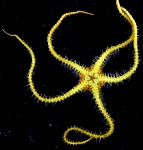 New web portal provides free and open access to information on antarctic marine species. The SCAR-MarBIN portal lets users browse, see and search different types of data, including over 2000 photos and videos. Entries are geo-referenced so users can discover what is found where.
New web portal provides free and open access to information on antarctic marine species. The SCAR-MarBIN portal lets users browse, see and search different types of data, including over 2000 photos and videos. Entries are geo-referenced so users can discover what is found where. The database now offers access to over one million records from 120 datasets. This was one of the ambitious objectives for the end of the International Polar Year (IPY). The data is updated by more than 70 experts worldwide. SCAR-MarBIN makes it possible to instantly download data and map the occurrence and abundance of polar marine organisms.
Antarctic marine ecosystems are particularly challenged by Global changes. More and more, the Southern Ocean is considered as a hotbed of marine speciation, having a considerable influence on Marine ecosystems worldwide.
SCAR-MarBIN is the information partner of the Census of Antarctic Marine Life (CAML), one of 17 projects of the Census of Marine Life.
What do you think of this news item? Join a discussion.
Labels: marine biology, SCUBA News, sealife
Monday, February 09, 2009
EU launches shark protection plan
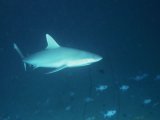 The European Commission has launched a Plan of Action for the Conservation and Management of Sharks. The aim is to rebuild shark stocks and to set down guidelines for the sustainable management of the fisheries, including where shark are taken as by-catch. The plan also hopes to increase knowledge of shark stocks and shark fisheries.
The European Commission has launched a Plan of Action for the Conservation and Management of Sharks. The aim is to rebuild shark stocks and to set down guidelines for the sustainable management of the fisheries, including where shark are taken as by-catch. The plan also hopes to increase knowledge of shark stocks and shark fisheries.European Commissioner for Maritime Affairs and Fisheries Joe Borg commented: "Sharks are very vulnerable to over-exploitation and the consequences of depleting their numbers may have very serious consequences not only for sharks but also for marine ecosystems and for fishermen themselves. That is why we have set out a plan of action which will both establish a more precautionary approach to managing fisheries where sharks are caught, and support the substantial research still needed to understand fully the role sharks play in the life of our oceans and the impact which fishing may have on them."
The Action Plan includes measures to improve data collection and to further reinforce control of the shark finning ban, which came into force in EU waters, and for all EU vessels wherever they fish, in 2003.
The Plan covers all cartilaginous fish – not only sharks, but also skates, rays and chimaeras, which make up over 1,000 species in total. They are found throughout the world, and particularly in the Northern Atlantic Ocean, where more than 50% of shark catches by EU vessels are made. Shark fisheries have grown rapidly since the mid-1980s, driven by an increased demand for shark products (fins in particular). But these species are especially vulnerable to overfishing, since they are long-lived, slow to reach sexual maturity, have long gestation periods and a low fertility rate. A recent study by the International Union for the Conservation of Nature suggests that as many as one-third of the shark species caught in EU waters are currently threatened by excessive fishing pressure. Despite the fragility of these stocks, and their growing importance to the EU fleet, EU shark fisheries have never been managed systematically.
Environmentalist organisations have broadly welcomed the plan. Steven Broad, Director of TRAFFIC, the wildlife trade monitoring network, commented "The commitment to shark conservation is to be commended, although TRAFFIC and WWF are deeply concerned that some of the measures will not be implemented for considerable periods".
Although the Plan calls for countries to collect information on sharks caught, this will be on a voluntary basis.
TRAFFIC and WWF also called on the EU to allocated adequate resources to ensure the Plan could be properly implemented, and for the Council and the European Parliament to adopt the plan without diluting the proposed measures or extending the period of implementation.
"Many of these species are already threatened with extinction. WWF and TRAFFIC are dismayed that the plan lacks a solid commitment to seek mandatory collection of data on shark catch—a critical element if the EU is to succeed in the conservation of these species," said Dr Susan Lieberman, WWF International's Species Programme Director.
Shark Alliance Policy Director, Sonja Fordham, said “The release of the long-awaited EU Shark Plan represents a great step forward for the conservation of sharks in European waters and beyond. The Plan’s commitments to science-based fishing limits, endangered species protection, and a stronger finning ban are essential to securing a brighter future for some of Europe’s most vulnerable and neglected animals.”
“The success of the EU Shark Plan depends on prompt, follow-up proposals from the Commission and cooperation from Member States in ensuring improvements are accepted and enforced,” added Fordham. “We urge all EU Fisheries Ministers to actively support timely implementation of the Shark Plan in line with scientific advice and the precautionary approach.”
Sharks are targeted by UK, French, Spanish and Portuguese fishermen; shark tails and meat are used to prepare "caldeirada" or "Schillerlocken" and shark meat is served in restaurants across Europe, and in the UK in traditional fish-and-chip shops.
Further Reading:
European Commission Fisheries
What do you think of this news item? Start a discussion.
Labels: environment, Europe, Mediterranean, SCUBA News, sealife, sharks
Monday, July 07, 2008
Cleaner fish create safe havens
Both cleaner and cleaned fish benefit from this behaviour. Cleaner fish are also thought to benefit from immunity to predation. They stroke their "clients'" with their fins to help persuade the predators not to eat them. Researchers in Australia have found that the more stroking the calmer the predator. And it wasn't just the cleaner fish who benefited. Other fish nearby the cleaner station experienced less aggressive behaviour from the predators. The suggests that cleaner stations act as safe havens from predator aggression.
Further Reading: Behavioral Ecology, doi:10.1093/beheco/arn067
Cleaner fish do clean!
--
What do you think of this news item? Start a discussion.
Bookmark with: del.icio.us | Digg | Newsvine | NowPublic | Reddit
|
--
Subscribe to SCUBA News (ISSN 1476-8011) for more free news, articles, diving reports and marine life descriptions - http://www.scubatravel.co.uk/news.html

Labels: fish, marine biology, research, sealife
Thursday, April 17, 2008
Bikini corals recover from atomic blast
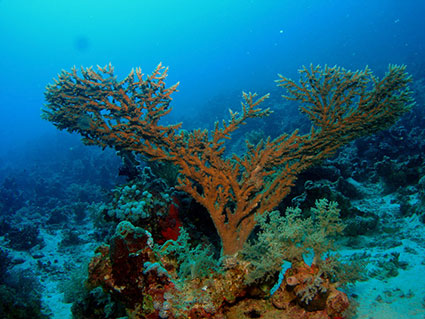 Half a century after the last earth-shattering atomic blast shook the Pacific atoll of Bikini, the corals are flourishing again. Some coral species, however, appear to be locally extinct.
Half a century after the last earth-shattering atomic blast shook the Pacific atoll of Bikini, the corals are flourishing again. Some coral species, however, appear to be locally extinct.These are the findings of a remarkable investigation by an international team of scientists from Australia, Germany, Italy, Hawaii and the Marshall Islands. The expedition examined the diversity and abundance of marine life in the atoll.
One of the most interesting aspects is that the team dived into the vast Bravo Crater left in 1954 by the most powerful American atom bomb ever exploded (15 megatonnes - a thousand times more powerful than the Hiroshima bomb). The Bravo bomb vapourised three islands, raised water temperatures to 55,000 degrees, shook islands 200 kilometers away and left a crater 2km wide and 73m deep.
After diving into the crater, Zoe Richards of the ARC Centre of Excellence for Coral Reef Studies and James Cook University says, “I didn’t know what to expect – some kind of moonscape perhaps. But it was incredible, huge matrices of branching Porites coral (up to 8 meters high) had established, creating thriving coral reef habitat. Throughout other parts of the lagoon it was awesome to see coral cover as high as 80 per cent and large tree-like branching coral formations with trunks 30cm thick. It was fascinating – I’ve never seen corals growing like trees outside of the Marshall Islands.
“The healthy condition of the coral at Bikini atoll today is proof of their resilience and ability to bounce back from massive disturbances, that is, if the reef is left undisturbed and there are healthy nearby reefs to source the recovery.”
However the research has also revealed a disturbingly high level of loss of coral species from the atoll. Compared with a famous study made before the atomic tests were carried out, the team established that 42 species were missing compared to the early 1950s. At least 28 of these species losses appear to be genuine local extinctions probably due to the 23 bombs that were exploded there from 1946-58, or the resulting radioactivity, increased nutrient levels and smothering from fine sediments.
“The missing corals are fragile lagoonal specialists – slender branching or leafy forms that you only find in the sheltered waters of a lagoon,” Zoe explains. While corals in general have shown resilience, Zoe adds that the coral biodiversity at Bikini Atoll has proven only partially resilient to the disturbances that have occurred there.
Extensive decontamination works have been carried out at Bikini atoll making it safe to visit, however local produce is unsafe to eat, and it is unlikely the Bikinian people will return to live on Bikini Atoll in the near future.
For comparison the team also dived on neighbouring Rongelap Atoll, where no atomic tests were carried out directly although the atoll was contaminated by radioactive ash from the Bravo Bomb and local inhabitants were also evacuated and for the most part, have not returned. The marine environment at this Atoll was found to be in a pristine condition.
The team thinks that Rongelap Atoll is potentially seeding Bikini’s recovery, because it is the second largest atoll in the world with a huge amount of coral reef diversity and biomass and lies upstream from Bikini.
Because of its incredible history and current undisturbed character Bikini Atoll is now part of a larger project to have northern Marshall Island Atolls World Heritage listed. The expedition served to illustrate the tragic history of the Bikinian people is not entirely reflected below the surface because the reefs of Bikini are recovering to present themselves as havens of abundance to the marine life of the Northern Pacific Ocean.
Journal Reference: Elsevier’s Marine Pollution Bulletin No. 56, March 2008 page 5-3-1-515.
Further Reading: ARC Centre of Excellence for Coral Reef Studies
What do you think of this news item? Start a discussion.
Bookmark with: del.icio.us | Digg | Newsvine | NowPublic | Reddit
|
--
Subscribe to SCUBA News (ISSN 1476-8011) for more free news, articles, diving reports and marine life descriptions - http://www.scubatravel.co.uk/news.html

Labels: coral, research, sealife
Wednesday, March 12, 2008
Global warming turns fish deaf
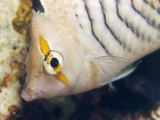 Is it important that global warming turns fish deaf? Yes. For coral reef fish, sound is vital for them to judge where to settle down and live.
Is it important that global warming turns fish deaf? Yes. For coral reef fish, sound is vital for them to judge where to settle down and live.After hatching, reef fish larvae are dispersed by ocean currents for a few weeks. The larval fish must then find their way back to a suitable reef to make their home.
It's thought that the young fish home in on high-frequency noises. Coral reefs are extremely noisy environments, with the crackle of snapping shrimps and the chatter of fish set against a backdrop of wind, rain and surf. Sound carries well underwater, and most fish have great hearing.
Global warming and more acidic oceans, though, can cause fish to be born with deformed earbones. Reasearchers at the Australian Institute of Marine Science in Townsville and the University of Edinburgh, suspected that it might be harder for these fish to pinpoint the origin of a sound, increasing the chance they would get lost in the ocean. And, indeed, their results show that this is so.
Journal References and Further Reading:
Proceedings of the Royal Society, Volume 275, Number 1634 / March 07, 2008
Animal Behaviour, doi:10.1016/j.anbehav.2007.11.004
SOUND: The essential navigation cue for young reef fishes to find their way home
--
What do you think of this news item? Start a discussion.
Bookmark with: del.icio.us | Digg | Newsvine | NowPublic | Reddit
|
--
Subscribe to SCUBA News (ISSN 1476-8011) for more free news, articles, diving reports and marine life descriptions - http://www.scubatravel.co.uk/news.html

Labels: coral reef, environment, fish, marine biology, research, sealife
Monday, March 03, 2008
Butterflyfish 'May Face Extinction'
 The Chevroned Butterflyfish may be at risk of extinction, scientists have warned.
The Chevroned Butterflyfish may be at risk of extinction, scientists have warned.The case of the Chevroned Butterflyfish is a stark example of how human pressure on the world's coral reefs is confronting certain species with 'blind alleys' from which they may be unable to escape, says Dr Morgan Pratchett of the ARC Centre of Excellence for Coral Reef Studies and James Cook University.
In a study published in the journal Behavioural Ecology and Sociobiology, Dr Pratchett and Dr Michael Berumen of Woods Hole Oceanographic Institution (USA) warn that the highly specialised nature of the feeding habits of this particular butterflyfish – the distinctively patterned Chaetodon trifascialis - make it an extinction risk as the world’s coral reefs continue to degrade due to human over-exploitation, pollution and climate change.
“The irony is that these butterflyfish are widespread around the world, and you’d have thought their chances of survival were pretty good,” Dr Pratchett said today.
“But they only eat one sort of coral – Acropora hyacinthus – and when that runs out, the fish just disappear from the reef.”
The team found it hard to believe a fish would starve rather than eat a mixed diet, so they tested C. trifascialis in tank trials on a range of different corals. The fish grew well when its favourite coral was available – but when this was removed and other sorts of corals offered, it grew thin, failed to thrive and some died.
“We call these kinds of fish obligate specialists. It means they have a very strong dietary preference for one sort of food, and when that is no longer available, they go into decline. We still don’t have a satisfactory scientific explanation for this, as it seems like rather a risky tactic in evolutionary terms – but it must confer some advantage provided enough of its preferred food is available,” Dr Pratchett says.
The A. hyacinthus coral, which the butterfly fish feeds on, is itself highly vulnerable – to attacks by plagues of crown-of-thorns starfish (thought to be triggered by humans releasing excess nutrients onto the reef as sediment, fertilizer or sewage), to storms and to the coral bleaching caused by the heating of ocean surface waters to 32 degrees or more, which is thought to be linked to global warming.
“Although extremely widespread, the Chevroned butterflyfish may be at considerable risk of extinction following ongoing degradation of coral reefs around the world, because the coral itself is exceptionally vulnerable, Dr Pratchett explains.
“It is estimated that up to 70 per cent of the world’s coral reefs are now badly degraded, which usually involves the loss of this particular coral – and, when it goes, the C. trifascialis also disappear from the reef.
“To make matters worse, butterflyfishes are one of the main families of coral reef fishes being targeted by aquarium collectors. However, the specialized coral-eaters are clearly not suitable for keeping in aquaria - and often die because they cannot obtain their main food source.”
A previous case in which a coral-dependent fish vanished occurred in the case of Gobiodon a specialized coral-dweller known only from one site, Kimbe Bay in Papua New Guinea, which was thought by scientists to have possibly become extinct after its habitat was destroyed.
Researchers consider that such extinctions are likely to occur as part of the global mass extinction of species now taking place, and that marine ecosystems may be particularly vulnerable in that small changes in habitat or water quality can have a big impact on their species.
Dr Pratchett and Dr Berumen say theirs is one of the few studies so far to consider the evolutionary and ecological basis of dietary versatility, and has implications for the fate of specialised feeders throughout the animal kingdom.
More information: ARC Centre of Excellence for Coral Reef Studies
-
What do you think of this news item? Start a discussion.
Bookmark with: del.icio.us | Digg | Newsvine | NowPublic | Reddit
|
--
Subscribe to SCUBA News (ISSN 1476-8011) for more free news, articles, diving reports and marine life descriptions - http://www.scubatravel.co.uk/news.html

Labels: medical, research, sealife
Thursday, December 20, 2007
New IMAX Film: DOLPHINS AND WHALES
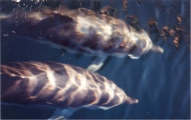 Filmmakers and environmentalists Francois and Jean-Jacques Mantello and ocean explorer Jean-Michel Cousteau are pleased to announce they have joined forces on the new 3D documentary film DOLPHINS AND WHALES 3D: Tribes of the Ocean, which will be released at IMAX (R) Theatres beginning on February 15th, 2008. This latest installment in 3D Entertainment’s unique ocean themed film series will deliver a strong and compelling conservation message while bringing audiences on a close encounter, for the very first time in 3D, with small and giant cetaceans such as humpback and sperm whales, orcas and dolphins.
Filmmakers and environmentalists Francois and Jean-Jacques Mantello and ocean explorer Jean-Michel Cousteau are pleased to announce they have joined forces on the new 3D documentary film DOLPHINS AND WHALES 3D: Tribes of the Ocean, which will be released at IMAX (R) Theatres beginning on February 15th, 2008. This latest installment in 3D Entertainment’s unique ocean themed film series will deliver a strong and compelling conservation message while bringing audiences on a close encounter, for the very first time in 3D, with small and giant cetaceans such as humpback and sperm whales, orcas and dolphins."I am delighted to be associated with this new, unforgettable underwater voyage where viewers will don their 3D glasses much in the same way we put on our diving masks and will be immersed in the rarely seen world of these fascinating but vulnerable creatures," says Jean-Michel Cousteau. "DOLPHINS AND WHALES 3D: Tribes of the Ocean is an ideal means of reaching a vast audience and helping individuals around the world to understand that we need to act responsibly in order to ensure the preservation of the world’s oceans and its inhabitants because, in the end, the most crucial partners whales and dolphins have are YOU and me."
"DOLPHINS AND WHALES 3D: Tribes of the Ocean will show a large variety of cetacean species, filmed exclusively in the wild, as they really are in their daily lives: interacting socially, playing, communicating through their highly complex system of sound, feeding, breeding, migrating and perpetually fighting for their survival," explains the film’s director, Jean-Jacques Mantello.
"Although each encounter with these wild creatures was truly magical and highly emotional, this marks one of the most challenging and epic productions I have ever taken on."
Principal photography began in June 2004 in Polynesia. An extensive three years were required to capture the footage during the course of 12 international expeditions and over 600 hours underwater at some of the remotest locations on Earth, including off the Pacific Ocean atolls of Moorea and Rurutu, Vava’u island of the Kingdom of Tonga, Pico Island in the Azores archipelago, the Valdez Peninsula in Argentina, Sapphire Coast of Australia, Bay of Islands in New Zealand and Canada's Hudson Bay. Unlike other IMAX-type documentaries, the film consists solely of underwater footage, with none of the usual “dive preparation” sequences.
The film trailer can been seen at http://www.DOLPHINSandWHALES3D.com
High-resolution photos from the film are available at http://www.3DEpublicity.com.
What do you think of this news item? Start a discussion.
Bookmark with: del.icio.us | Digg | Newsvine | NowPublic | Reddit
|
--
Subscribe to SCUBA News (ISSN 1476-8011) for more free news, articles, diving reports and marine life descriptions - http://www.scubatravel.co.uk/news.html

Labels: sealife, whale and dolphins
Tuesday, October 30, 2007
No sunglasses required for fish supper

Fishermen are always looking for a tasty catch - but it is the fish that have a natural advantage when it comes to spotting dinner, according to new research from The University of Manchester.
In a paper published this month in the Biophysical Journal, Dr Nicholas Roberts reports how individual light sensitive cells within the retina of goldfish are able to detect polarised light.
It's believed this type of polarisation vision improves visual contrast and can help an animal catch its prey more easily.
Researchers say this latest research is important because it is the first direct experimental evidence of a polarisation detection mechanism in any normal vertebrate eye.
Dr Roberts says: "Vision is the primary sense of many animals and the way they see their world is of fundamental importance to understanding aspects of their behaviour.
"Numerous animals have amazing visual abilities, which allow them to see the world in very different ways. One such ability is polarisation vision.
"Just as fishermen wear Polaroid sunglasses to help improve contrast, many different animals - including fish - have evolved to do the very same thing without the need of sunglasses. It is a surprisingly common ability throughout the animal kingdom."
Journal Reference: Biophys J. 2007 Nov 1;93(9):3241-8.
Photo Credit:US National Oceanic and Atmospheric Administration
What do you think of this news item? Start a discussion.
Bookmark with: del.icio.us | Digg | Newsvine | NowPublic | Reddit
|
--
Subscribe to SCUBA News (ISSN 1476-8011) for more free news, articles, diving reports and marine life descriptions - http://www.scubatravel.co.uk/news.html

Labels: fish, research, sealife
Monday, September 24, 2007
Blue Tang is Creature of the Month

Blue Tangs are often found roaming the reef, in search of their favourite food - algae. They are surgeonfish which may appear either singly or in large schools, which can contain hundreds of individuals.
The name surgeonfish comes from the defensive spines located on the caudal peduncle (the part of the fish between the tail and the rest of the body) which are as sharp as a surgeon's scalpel. They are herbivorous, eating plants and algae, so their spines are used only for defense.
Blue Tangs are sometimes found schooling with other members of the surgeonfish family. These schools form around dusk when nocturnal predators, such as moray eels, begin to hunt. These schools provoke an aggressive reaction from the smaller damselfishes defending patches of algae.
The true Blue Tang is Acanthurus coeruleus, which found in the Caribbean Sea. Other fish are also sometimes referred to as Blue Tang. In the Red Sea, for example, there is Zebrasoma xanthurum, more properly known as Yellowtail Tang. Also in the Indo-Pacific masquerading as Blue Tang is the Palette Surgeon, Paracanthurus hepatus; familiar if you've watched the "Finding Nemo" film.
As you might expect, blue tangs are largely blue. The Caribbean Blue Tang, Acanthurus coeruleus, has a bright yellow or white spine. It lives between 3 and 28 m on rocky or coral reefs. As it is unafraid of divers you can usually get quite close to it.
The Blue Tang, and other surgeonfish, are important on a shallow coral reef because they help keep the algae in check. Without them the algae would grow so fast that coral larvae settling and trying to make a start on the reef would soon be overgrown.
Further reading:
Beautiful Oceans Coral Reef Architecture & Organisms,
The Blue Planet
What do you think of this news item? Start a discussion.
Bookmark with: del.icio.us | Digg | Newsvine | NowPublic | Reddit
|
--
Subscribe to SCUBA News (ISSN 1476-8011) for more free news, articles, diving reports and marine life descriptions - http://www.scubatravel.co.uk/news.html

Labels: fish, marine biology, sealife
Wednesday, July 04, 2007
How fish punish queue jumpers
 Fish use the threat of punishment to keep would-be jumpers in the mating queue firmly in line and the social order stable, a new study led has found.
Fish use the threat of punishment to keep would-be jumpers in the mating queue firmly in line and the social order stable, a new study led has found.Studying small goby fish at Lizard Island on Australia's Great Barrier Reef, Dr Marian Wong and colleagues have shown the threat of expulsion from the group acts as a powerful deterrent to keep subordinate fish from challenging those more dominant than themselves.
In fact the subordinate fish deliberately diet - or starve themselves - in order to remain smaller than their superiors and so present no threat that might lead to their being cast out, and perishing as a result.
"Many animals have social queues in which the smaller members wait their turn before they can mate. We wanted to find out how they maintain stability in a situation where you'd expect there would be a lot of competition," says Dr Wong.
In the case of the gobies, only the top male and top female mate, and all the other females have to wait their turn in a queue based on their size - the fishy equivalent of the barnyard pecking order.
Dr Wong found that each fish has a size difference of about 5 per cent from the one above and the one below it in the queue. If the difference in size decreases below this threshold, a challenge is on as the junior fish tries to jump the mating queue - and the superior one responds by trying to drive it out of the group.
Her fascinating discovery is that, in order to avoid constant fights and keep the social order stable, the fish seem to accept the threat of punishment - and adjust their own size in order to avoid presenting a challenge to the one above them.
"Social hierarchies are very stable in these fish and in practice challenges and expulsions are extremely rare - probably because expulsion from the group and the coral reef it occupies means almost certain death to the loser.
"It is clear the fish accept the threat of punishment and co-operate as a way of maintaining their social order - and that's not so very different to how humans and other animals behave."
Dr Wong said that experimentally it has always proved extremely difficult to demonstrate how higher animals, such as apes, use punishment to control subordinates and discourage anti-social activity because of the difficulty in observing and interpreting their behaviour.
In the case of the gobies the effect is much more apparent because they seek to maintain a particular size ratio relative to the fish above them in the queue, in order not to provoke a conflict.
"The gobies have shed new light on our understanding of how social stability is maintained in animals," she says.
The paper entitled "The threat of punishment enforces peaceful cooperation and stabilizes queues in a coral-reef fish" was co-authored with Dr Philip Munday and Professor Geoff Jones of CoECRS and Dr Peter Buston of the Biological Station of Doñana, Spain. It appears in Proceedings of the Royal Society B, 274.
What do you think of this news item? Start a discussion.
Bookmark with: del.icio.us | Digg | Newsvine | NowPublic | Reddit
--
Subscribe to SCUBA News (ISSN 1476-8011) for more free news, articles, diving reports and marine life descriptions - http://www.scubatravel.co.uk/news.html

Labels: environment, fish, marine biology, research, sealife
Friday, May 25, 2007
Review: On-Line Coral Reef Course
Coral Reef Ecosystem & Food Web Course
$59.55
http://www.beautifuloceans.com/
This new course for divers discusses the coral reef ecosystem and food web. It illustrates its points using animals and plants found in and around coral reefs. For instance, the Caribbean Reef Shark is discussed as a top-level, active, predator. The authors manage to pack loads of information on their example species into a small space, without the prose becoming uninteresting. And even when I thought I knew lots about a subject they managed to surprise me. For instance, did you know that sponges may be able to live to over 1000 years old?
Although much of the information applies to coral reefs throughout the world, the example species are found in the Caribbean.
By the end of the course its authors hope that you will have learnt to appreciate all life on coral reefs from the tiniest phytoplankton to the shark. You will also have learnt how each creature is interconnected with the others.
The course is available on-line, where you work through at your own pace at your computer. It includes videos of animal behaviour and interactive quizzes. You can also take the course at selected dive schools in the Caribbean.
The course materials are well written, with many interesting asides. The Manual, in pdf format, is 119 pages long. It has a comprehensive index and is lavishly illustrated with a high-quality photograph or diagram on nearly every page.
We are delighted to be able to offer our newsletter subscribers the chance to win the course. Subscribe at http://www.scubatravel.co.uk/news.html then send us an e-mail with "Beautiful Oceans" as the subject line. Closing date is 11 June. Your e-mail entries will not be passed to any other company unless you win, in which case Beautiful Oceans will be in touch with you.
For more information visit http://www.beautifuloceans.com/
Bookmark with: del.icio.us | Digg | Newsvine | NowPublic | Reddit
What do you think of this news item? Start a discussion.
--
Subscribe to SCUBA News (ISSN 1476-8011) for more free news, articles, diving reports and marine life descriptions - http://www.scubatravel.co.uk/news.html

Labels: Caribbean, coral, environment, marine biology, sealife
Friday, May 11, 2007
Egypt Stops Reef Fish Exports

Egypt have cancelled a decree which allowed companies to collect reef fish and export them to Europe and other markets .
According to the Hurghada Environmental Protection and Conservation Association (HEPCA), the previous decision had a devastating effect on nature and on the coral reef condition in the whole area. HEPCA launched a huge campaign against this decision and lobbied with other agencies, enthusiastic individuals, and major media representatives.
As a result of the decision HEPCA have ceased legal actions against the Minister's old decree.
Further Reading: http://www.hepca.com/
What do you think of this news item? Start a discussion.
--
Subscribe to SCUBA News (ISSN 1476-8011) for more free news, articles, diving reports and marine life descriptions - http://www.scubatravel.co.uk/news.html

Labels: environment, fish, Red Sea, SCUBA Travel, sealife
Thursday, May 10, 2007
Scientists Start Encyclopedia of Life
 The world's scientists plan to document all 1.8 million named species on a web site for all to see.
The world's scientists plan to document all 1.8 million named species on a web site for all to see.The project, called the Encyclopedia of Life, will provide written information and, when available, photographs, video, sound, location maps and other multimedia information on each species. Built on the scientific integrity of thousands of experts around the globe, the Encyclopedia will be a moderated wiki-style environment, freely available to all users everywhere.
To provide depth behind the portal page for each species, the Biodiversity Heritage Library (BHL), a consortium that holds most of the relevant scientific literature, will scan and digitize tens of millions of pages of the scientific literature that will offer open access to detailed knowledge. In fact, the BHL now has scanning centers operating in London, Boston, and Washington DC, and has scanned the first 1.25 million pages for the Encyclopedia. They estimate that some species pages will be available by 2008, but the full Encyclopedia will take around 10 years.
“The Encyclopedia of Life will be a vital tool for scientists, researchers, and educators across the globe, providing easy access to the latest and best information on all known species,” said Jonathan F. Fanton, President of the John D. and Catherine T. MacArthur Foundation. “Technology is allowing science to grasp the immense complexity of life on this planet. Sharing what we know, we can protect Earth's biodiversity and better conserve our natural heritage.”
Further Reading: THE ENCYCLOPEDIA OF LIFE
What do you think of this news item? Start a discussion.
--
Subscribe to SCUBA News (ISSN 1476-8011) for more free news, articles, diving reports and marine life descriptions - http://www.scubatravel.co.uk/news.html

Labels: marine biology, sealife
Friday, May 04, 2007
The Seahorse is Creature of the Month

Seahorses are delightful to spot, curling onto sponges, coral or sea grass. They range in size from the tiny Hippocampus denise which is just 16 mm, to the 35 cm (1 foot) Pacific seahorse.
Seahorses are not easily seen as they blend in with their surroundings. They can change skin colour to match their environment and even grow skin filaments to imitate seaweed or sea grass growths.
The seahorse is remarkable as the male becomes pregnant. The female seahorse deposits her eggs into the male's pouch where they are fertilised. The eggs remain in the male's pouch until they hatch, when the male gives birth to tiny seahorses. The time to hatching takes between 10 days and four weeks, depending on the species and water temperature. Male seahorses are often pregnant for as many as 7 months in the year. The natural lifespan of seahorses is not known, but believed to be from one year for small species to five years for a larger species.
Seahorses are opportunistic predators, sitting and waiting until prey come close enough and then sucking them rapidly from the water with their long snouts. Their eyes move independently of each other, maximizing their search area. They will eat anything small enough to fit into their mouths
The name hippocampus comes from the ancient Greek, loosely hippos meaning horse and campus meaning sea monster. Hippocampi refer to the mythical creatures on which the sea gods rode. Early zoologists initially classified seahorses as insects not fish.
All seahorses for which data is available are listed on the IUCN Red List of Threatened Species as either Vulnerable or Endangered. This means they are facing a high risk of extinction in the wild. There are many reasons for their vulnerability. Seahorses are exploited for traditional medicines and the aquarium trade. Male brooding means that young depend on parental survival for far longer than in most fish. Many species are monogamous so widowed animals don't reproduce until they have found a new partner. Their low population density and low mobility means that this can take some time. Habitat degradation is also a real threat to populations as they mainly inhabit shallow, coastal areas, which are highly influenced by human activities.
Further Reading
IUCN 2006. 2006 IUCN Red List of Threatened Species. <www.iucnredlist.org>. Downloaded on 20 April 2007.
Project Seahorse - http://seahorse.fisheries.ubc.ca/
Seahorse photo taken in Dominica, copyright Harald Jahn.
What do you think of this news item? Join a discussion.
Labels: Caribbean, Dominica, fish, seahorse, sealife
Thursday, April 19, 2007
Cuckoldry incites cannibalism: Male Fish eat offspring
In field observations of Telmatherina sarasinorum, a small fish endemic to Sulawesi, Indonesia, males increased filial cannibalism behavior threefold in the presence of one cuckolder and nearly sixfold in the presence of two or more cuckolders. The researchers Suzanne Gray, Lawrence Dill and Jeffrey McKinnon suggest that "males may use detection of cuckolders as an indication that the paternity of current offspring has been compromised".
The evolution of filial cannibalism is thought to be driven by an energetic trade-off between caring for the current brood and investing in future reproductive success by eating offspring. In species with male parental care, a male's assessment of the value of the current brood can incorporate information on his own energy reserves, the quality and availability of mates, prey availability and his perceived certainty of paternity. If a male perceives that the value of his current brood is low, then eating it may improve his future reproductive success.
Most work, and all theory, on the evolution of filial cannibalism has previously focused on understanding the energetic trade-off in fishes that provide parental care, mostly by males. Parental care requires an investment in both time and energy spent rearing or guarding offspring, whereas in the absence of parental care, there is no energetic cost beyond mating. In both cases, eating offspring is expected to add to future reproductive success through an energy gain; however, parental caregivers could also benefit by relieving themselves of low-value offspring.
Perceived certainty of paternity based on visual detection of cuckolders by a male could immediately indicate the value of potential offspring by providing information on expected relatedness. Filial cannibalism could be a tactic to recoup energy lost to mating efforts (e.g., through aggressive male-male interactions over mates) and hence increase energy for the next mating bout. The cost to a male of mistakenly consuming some of his own eggs may be high with respect to his reproductive fitness. However, this cost may be outweighed by the benefit of securing more energy to find another mating opportunity where his certainty of paternity is higher.
Journal reference: American Naturalist 2007. Vol. 169, pp. 258-263.
What do you think of this news item? Start a discussion.
--
Subscribe to SCUBA News (ISSN 1476-8011) for more free news, articles, diving reports and marine life descriptions - http://www.scubatravel.co.uk/news.html

Labels: marine biology, sealife
Tuesday, April 10, 2007
Turtle hatchery established in North Sulawesi
With the advice and support of the WWF in Indonesia, the NSWA has established a turtle hatchery in Bunaken Marine Park on a section of beach where the turtles come ashore to lay their eggs. To ensure minimum interference in the natural process only those eggs at risk from being swept away by high tides will be moved to the hatchery to give them a better chance of survival. Any eggs laid by turtles that are safe will be left in place but will be monitored to make sure that they are well protected and untouched during the 45-60 day period of incubation.
The chances of survival for young turtles are quite slim and the NSWA hopes that the establishment of the hatchery will boost the odds for them. It takes 35 years before a turtle is sexually mature and once fertilized the female returns to the beach on which she was born to lay her eggs. They have been known to swim right across the Pacific in order to return to the beach of their birth. When the baby turtles hatch they have to scramble across the sand to reach the sea, a time when they are very vulnerable from swooping sea birds looking for an easy meal. Once in the sea they are still open to attacks from predators.
The first turtle laid 120 eggs on 13th February close to the hatchery and the NSWA reports that all is going well and they are expected to hatch in early April. Many more turtles are expected soon as the peak nesting season is between now and the end of June. The NSWA are using the opportunity to involve local schoolchildren in the monitoring process to educate them about the turtles and their importance in the balance of all marine life.
What do you think of this news item? Start a discussion.
--
Subscribe to SCUBA News (ISSN 1476-8011) for more free news, articles, diving reports and marine life descriptions - http://www.scubatravel.co.uk/news.html

Labels: environment, sealife, turtles
Friday, March 09, 2007
Mexico Passes Shark Finning Ban
"Mexico has taken a real leadership position here" says Patric Douglas CEO of Shark Diver (www.sharkdiver.com). "The rest of Latin America is watching what Mexico does with great interest now, this is good news indeed".
In the past few years Mexico has been recognized as one of the few places on the planet where large congregations of Great White sharks appear each year at Isla Guadalupe. Along with Whale shark aggregations in Holbox, destination tourism with these shark species and others is growing.
Captain Mike Lever owner of expedition dive vessel MV Nautilus Explorer was thrilled at the news "The people of Mexico afford us a great privilege in allowing us to dive with the white sharks at Guadalupe Island. The February 14th enactment of Mexican rules for responsible shark and ray fisheries is incredibly good news and really bodes well for the survival of these magnificent animals. Our hats are off to all of the scientists who helped make this happen".
The new rules and regulations came after 10 years of debate and the broad support of researchers, scientists, conservations groups, eco-tour operations and local citizens.
What do you think of this news item? Start a discussion.
--
Subscribe to SCUBA News (ISSN 1476-8011) for more free news, articles, diving reports and marine life descriptions - http://www.scubatravel.co.uk/news.html

Labels: environment, sealife, sharks
Wednesday, March 07, 2007
Geometric Moray Eel is Creature of the Month
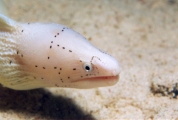
The Geometric moray has a long body with one continuous fin along its back. Like other morays it has elongated nostrils. You can easily recognise it by the dashed lines patterning its face, as shown in our photo.
Morays live in holes and generally hunt by night, locating
their prey by their excellent sense of smell. Moving with
snake-like motions, they are extremely quick. When at rest
you may see them rhythmically opening and closing their
mouths. They do this to maintain a respiratory current
past the gills.
The Geometric moray is the most common eel in the Red Sea.
It is also found throughout the Western Indian Ocean:
Madagascar, Mauritius, Oman, Mozambique, Seychelles,
South Africa, etc.
Quite small for a moray, the Geometric moray reaches
65 cm long. It lives at depths down to 40 m on coral and
rocky reefs. You may see groups of up to 10 young eels
sheltering in rock crevices.
The black dashes on the face and body of this moray mark
its pores. These are part of its lateral line system which
detects changes in pressure and so can be used to detect
movement and vibration in the surrounding water.
The Geometric moray, Siderea grisea is also known as the Grey Moray and Gymnothorax griseus.
What do you think of this news item? Start a discussion.
--
Subscribe to SCUBA News (ISSN 1476-8011) for more free news, articles, diving reports and marine life descriptions - http://www.scubatravel.co.uk/news.html

Labels: fish, marine biology, sealife